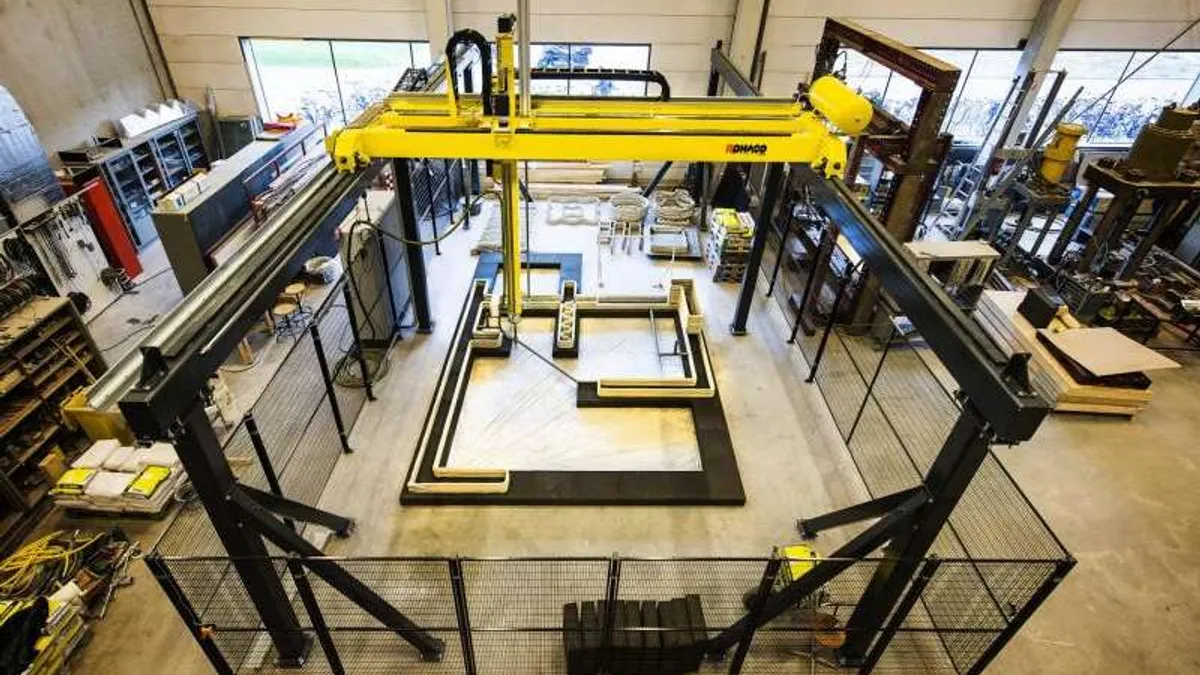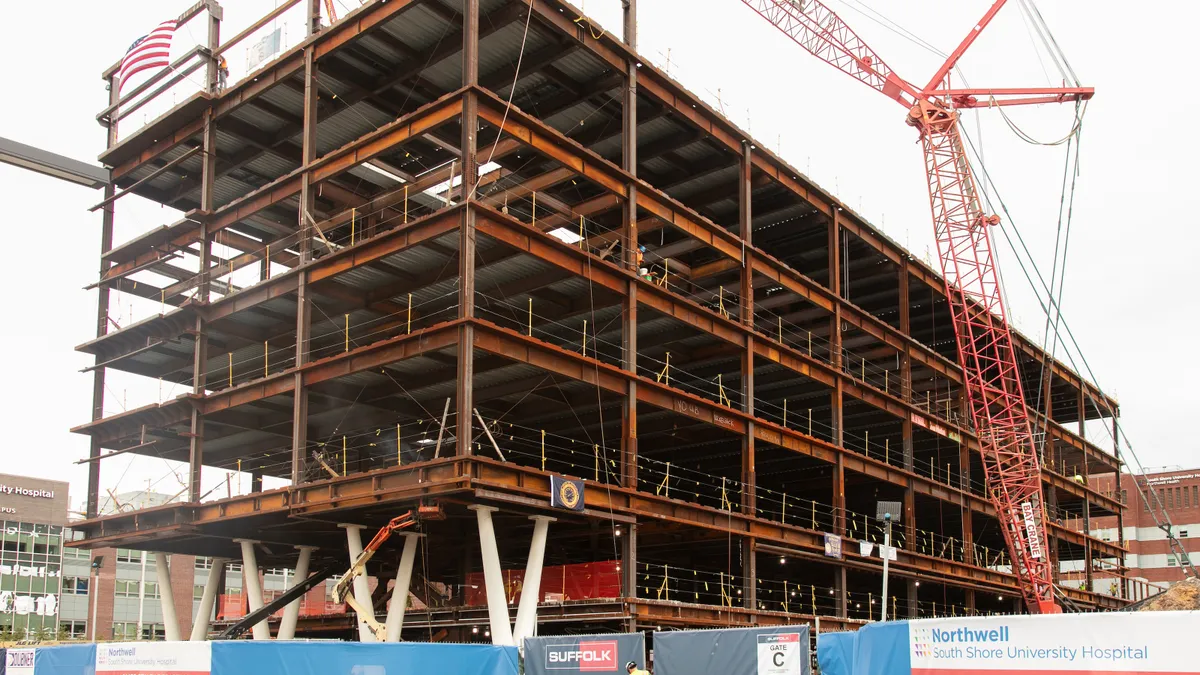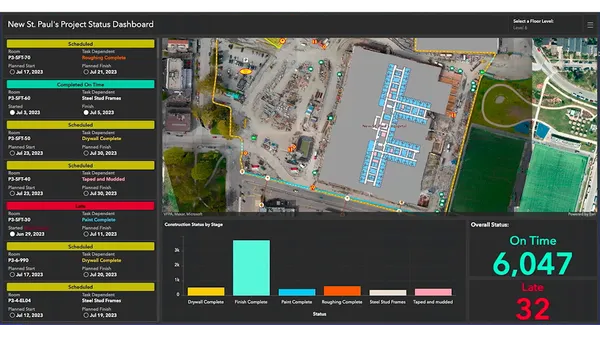As 2015 comes to a close, we're taking a look back at the most interesting technological advancements in the construction industry throughout the last year. In the past, construction was somewhat behind the times when it came to adopting new technologies. However, 2015 saw countless instances of advancements that could have major impacts on the industry. As we head into 2016 and a new year of innovation, here are the eight coolest technology stories from 2015.
1. Construction robotics startup developing technology to revamp building process
In September, we reported on construction robotics startup Asmbld, based in Brooklyn, NY, which is working on a robotics system that can reconfigure a room in minutes, and which co-founder Petr Novikov called "like 3-D printing upside down," according to TechCrunch.
The "Project Dom Indoors" process involves tiny robots living inside cubes created from 5-inch tiles and aluminum studs that make up the floor of a room. Those cubes can rise out of the floor to create walls, surfaces and tables, and then slide back into their original position in the floor. The robots have the ability to assemble the cubes into new configurations, transforming a conference room into a lounge or open workspace, for example. Watch a demonstration of the system here.
Asmbld said it would cost approximately $12,000 to install the system in a 500-square-foot room, and would involve re-flooring a space to make the floor 5 inches higher than the current floor. Asmbld's technology could reduce construction and demolition waste, as reconfiguring and redesigning rooms wouldn't need to result in any waste. And replacing construction workers with the tiny robots offers the opportunity for major time and labor costs, the founders said.
2. Nation's 1st 3-D printed estate slated for 2017
A New York architect announced plans in June to use a giant military 3-D printer to create an estate that will include a 2,400-square-foot house, a swimming pool, a Jacuzzi and a carport.
Architect Adam Kushner and 3-D-building company D-Shape said they planned to mix sand, dust and gravel with a binding agent containing magnesium and use the printer to produce a material with the consistency of marble, which they will use as building blocks, according to CNN.
The project, when completed in late 2017, will be the first printed estate in the U.S. The Netherlands and China already have homes created from 3-D-printed materials. Although 3-D estates, for now, are for the wealthy, the architect told CNN that the technology could allow for faster building and eventually be cheaper and offer higher quality than traditional construction materials and practices.
3. FL to test self-driving crash trucks at roadside work zones
A Coopersburg, PA, equipment company unveiled a self-driving truck in August to soon be used by highway construction crews in Florida.
The driverless vehicles will serve as construction-site "crash trucks" — the barrier-surrounded vehicles that lead the roving construction crews that paint highway lines, inspect bridges and pave roads. Drivers of crash trucks are constantly in danger, even when their vehicles serve as a decoy to divert traffic from hitting exposed road workers. A driverless vehicle eliminates the risk of harm in case a moving car hits the truck.
Each truck is equipped with a device that will receive signals to direct its movement. Automated crash trucks, which are drawing interest from transportation departments around the country, can also potentially save money on labor, as fewer drivers would be needed per crew.
4. New 3-D printer builds 1,000 square feet per day
As we reported in October, Russian engineer Nikita Chen-yun-tai developed a 3-D printer that can create a 1,000-square-foot building of any height in one day. The Apis Cor printer, shaped like a tower crane, sets up in the middle of the building and can print a house layer by layer, at high speed, with a commercial extruder rotating in two planes, according to 3dprint.com.
The Apis Cor has a printing zone of up to 630 square feet, can print sloping walls horizontally and vertically, produces no construction waste, and provides a cost savings of up to 70% over frame construction.
The use of 3-D printing in construction is a hot topic in the industry, and news of the Apis Cor came soon after another high-profile house printer, WASP's Big Delta.
5. The future of concrete? Parking lot 'drinks' 1,000 gallons of water in 1 minute
Interest in permeable concrete — primarily its ability to prevent devastating damage caused by stormwater runoff — skyrocketed in September due to a video demonstration in which a parking lot paved with a product called Topmix Permeable absorbs more than 1,000 gallons of water in a minute.
According to Lafarge Tarmac, manufacturer of Topmix Permeable, stormwater routinely overwhelms older U.S. wastewater systems, causing untreated sewage to be dumped into local waterways and onto public beaches and creating a significant source of pollution for rivers, streams and reservoirs.
Products like Topmix Permeable are applied over a base layer of gravel and, depending on the permeability of the substrate, the water is allowed to either permeate the ground below or is diverted elsewhere, over a period of time, through a series of pipes. However, the empty spaces in the permeable concrete that allow water to flow through have limited the product's use in more rigorous applications, such as heavily-traveled highways, and have raised questions about possible damage from freezing water.
6. Will 3-D printing make in-space construction a reality?
Made In Space, which bills itself as a "space manufacturing company," and NanoRacks, which helps its commercial clients make use of the International Space Station, announced their partnership in August to launch a 3-D printer into space to build tiny satellites far above Earth.
The so-called Cubesats will be assembled in orbit from the printed parts and then deployed into space — which could result in "the first off-Earth assembly line," according to Space.com.
Made in Space President Andrew Rush said satellites constructed in space will be lighter and built faster because they will not need to be designed to withstand a launch. And satellites and other objects printed and assembled in space can be larger than pre-built products launched from Earth because builders will not have to comply with size and weight restrictions in order to fit the components onto a rocket.
Astronauts installed an experimental 3-D printer at the space station last fall, which NASA has used to test-print a number of parts for satellites, according to Space.com.
7. Japanese firm tries replacing hard-to-find construction crews with robotic equipment
In February, a Japanese construction equipment maker proposed replacing crews with robots as a solution to the labor shortage the country has in common with the U.S. A plan by Komatsu, whose drones are made by San Francisco company Skycatch, involved unmanned drones taking videos and photographs of a job site, and then sending them to a computer that would replicate the site in a 3-D model.
Komatsu also implemented a team of driverless, robotic excavation vehicles that are guided by drones, which create a real-time 3-D map of the area to track the work site.
A Komatsu spokesman told The Wall Street Journal that labor shortages are critical in Japan, as construction ramps up for the 2020 Summer Olympics in Tokyo. The company experimented with ground-level scanners, but found that the airborne drones worked better, according to the spokesman.
8. 3-D printed home, car that can share energy to be created from same material
Science and technology researchers at Oak Ridge National Laboratory unveiled a house and a car— made from components printed on a 3-D printer — in September that can transfer energy to one another. Clayton Homes, the largest U.S. manufacturer of modular homes, and Chicago-based architecture firm Skidmore, Owings & Merrill worked with Oak Ridge to design and build the house and car, according to 3dprint.com. Both were printed on a fast 3-D printer called BAAM with a carbon fiber-reinforced polymer material, similar to the material used to make the world's first 3-D-printed car in 2014.
Houses and cars created from 3-D printers are still rare, but this project is a first among them, as both structures were printed from the same material, and a wireless connection between the two allows the electric-hybrid car, which has a natural gas generator, to power the home when the structure's solar panels do not produce enough electricity to keep it up and running. In return, the home's excess solar energy can charge the vehicle.
Roderick Jackson, Oak Ridge's head of building envelope systems research, called the project "a radical version of 3-D printing" that cut time and materials by 40% when compared with similar, traditionally built cars and houses.




















